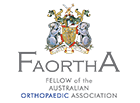Initial Treatment
Initially the knee will have to be reduced. The knee will be placed in a brace, or in plaster. On occasion an external fixator may need to be applied if the knee cannot be held reduced due to its gross instability. Pain control is extremely important. Performing all necessary investigations to gain as much information as possible is important.
Options for Treatment
There is no role for non-operative treatment, unless circumstances are extremely extenuating in nature.
Operative treatment is the treatment of choice.
What kind of operation a person gets does depend on what ligaments have ruptured.
Not all ligaments need to be reconstructed and they do not need to be done at the same time either (that is the surgeon can do the operations required at different times to reconstruct the ligaments).
If the operation occurs early then ligaments outside of the knee joint (LCL, MCL, PLC, PMC) may be able to be repaired rather than reconstructed.
What is the Difference Between Reconstruction and Repair?
Reconstruction is where the ligament that has torn or ruptured is replaced by another piece of tissue, most commonly a tendon.
The difference between a tendon and a ligament is that a tendon joins a muscle to bone and a ligament joins a bone to a bone.
Repair is where the ligament is stitched (sutured) back together.
What Type of Graft Will I Get?
The type of graft someone gets is based on a number of factors that Nigel will discuss with you.
Essentially there are three graft choices that Nigel can use from you:
- Hamstrings graft (from the same or other leg)
- Patella Tendon graft (from the same or other leg)
- Quadriceps graft (from the same or other leg)
He will also need to use one of the two following types of graft (Nigel will explain why he has to do this):
- Allograft (this is graft taken from someone else. It could be a living relative or taken from someone who is deceased)
- Artificial or man-made grafts (Very rarely Nigel will use these. In certain situations and people they may be required).
Does it Matter What Graft I Get?
- Yes it does matter what graft you get.
- There are pro’s and con’s to each of the different grafts that could be used.
- Nigel will discuss with you the benefits and risks of the different graft types.
- The graft that is most suitable for you is dependent on a number of factors and something that Nigel will discuss with you.
In the Clinic
If surgery is required this will be undertaken either at:
- North Park Private Hospital or
- St. Vincent’s Private Hospital Kew
Nigel will ask you to see an Anaesthetist and physician if you have any medical conditions that may affect the kind of anaesthetic used, and Nigel will also ask that you contact a physiotherapist to start prehabilitation and for a brace to be fitted to your knee.
Preoperative and Postoperative information – MLKI Reconstruction
Activities
It is important to keep your knee moving and the muscles around the knee working. The Quadriceps (thigh) muscles can lose up to 50% of their size within one week of an injury to the knee. Maintaining your core strength is important. Attending physiotherapy for a pre-surgery program of knee strengthening is important.
Activities that are good for your knee are:
- Cycling (stationary or road)
- Walking
- Weights work
- Squats or leg-press
- Gym work
- Treadmill
- Elliptical trainer
- Rowing machine
- Spin classes
- Pilates / Yoga
You can do these but there will be certain activities that you will not be able to do.
Activities that are not good for the knee are:
- Weights work: No leg extensions or hamstring curls – these place unnatural forces acrossthe knee joint.
- Running: Not advised, but if you want to run do so in a straight line, on a flat surface.
- Sport: Nigel will counsel against playing sport until 9 months after reconstruction and a return to sport test has been undertaken.
Before the operation
Nigel will ask that you contact a physiotherapist to start pre-habilitation on your knee.
On the day of surgery you will be seen by a number of staff members:
- Nurses
- Assistant
- Anaesthetist
- Hospital Physiotherapist
Nigel will see you and your leg will be:
- Clipped
- Washed with an anti-septic solution
- marked so that the correct side is operated on
A needle will be put into one of your veins so that medication and fluid can be given during the surgery. You will then be given an anaesthetic that will make you fall asleep. Antibiotics will be given to prevent infection from occurring.
The operation
Multi-ligament knee reconstruction (MLKR) is performed as a combination of arthroscopic and open procedure, dependent on what ligaments are injured. The operation length is variable dependent on what ligaments are injured.
- Nigel will prepare what grafts are required and will then perform an arthroscopy of your knee.
- Photographs and video of the inside of your knee will be taken (and will be given to you).
- Any other structures that have been damaged will be operated on before the ligaments are reconstructed or repaired.
- The knee is tested once more for stability before local anaesthetic is placed into the wounds and the wounds are sutured (sewn) with an absorbable suture (no stitches that need to be removed).
- Waterproof dressings are put over the wounds and the knee is bandaged.
Immediately after the operation
- You will be sore, even though pain medication has been given, and Nigel has put local anaesthetic around your knee.
- Your knee will be bandaged and you will have a brace around your knee.
- You will have white stockings on and will have foot pumps to aid circulation.
- You will have a number of pain killing medications prescribed and if you can tolerate an anti-inflammatory medication will also be available.
- ICE will be placed onto your knee.
- You will be transferred back to the ward once your observations are stable.
On the ward
- You will be able to have food and drink once you feel up to it.
- ICING your knee will be encouraged.
- Pain-killermedications will be offered.
- You will be encouraged to get out of bed and start walking, with crutches, either with the physiotherapist or nursing staff.
- Nigel will come to see you towards the end of the day and will explain the results of the surgery.
Day 1 post-surgery
- Nigel will come and see you in the morning
- Your dressings may be changed
- You will have an x-ray prior to going home
- Discharge from hospital is dependent on a number of factors
- The physiotherapist will see you
Discharge
- When you are due to go home you will be given a prescription for aspirin, pain-killers and an anti-inflammatory if you can take them.
- Your appointment to see Nigel will be given to you for 2 weeks after the operation (if not please contact Nigel’s secretary).
- The physiotherapist will make sure you have follow-up arranged.
- The nurses will reiterate the importance of:
- ICING your knee 30 minutes 4-5 times / day
- Keeping your leg elevated
- Keeping your foot moving (prevention of blood clots)
- Moving your knee as comfort allows
At home
- Continue with ICING your knee. Icing your knee is important to reduce the swelling. The quicker you reduce the swelling, the less painful the knee will feel, and the quicker you will get movement back in your knee.
- Keep taking your pain-killing medications.
- Use your crutches.
- Exercise your knee as comfort allows.
- If you have any doubts please read the post-operative rehabilitation protocol, contact Nigel’s rooms or your physiotherapist.
- Keep moving your foot (to prevent blood clots).
Complications
As with any surgery, potential complications can occur, however the risk is low. Complications following ACL reconstruction include:
- Infection 1:200
- Deep vein thrombosis (blood clots)
- Swelling
- Bruising
- Nerve injury / Some degree of numbness 25%
- Knee stiffness 5%
- Pain
- Damage to other structures in the knee
- Graft rupture
- Osteoarthritis
- Great care is taken to prevent all known complications, however occasionally they do occur and need prompt attention. Please feel free to contact Nigel if you have any concerns regarding complications.
Infection
Infection of the wound or skin surrounding the skin (cellulitis) occurs in about 1-2% of people. When this occurs you will have to take antibiotics to settle the infection. Infection in the knee joint occurs in 0.5% (1 in 200) – If this occurs, your knee joint will have to be washed out with a further operation and you will have to go on to antibiotics given through an Intra-venous (IV) drip.
If you develop any of the following signs:
- Redness
- Extra warmth
- Feeling unwell
- Pain in your groin
- Extra pain around your knee
- Sweats
- Fevers
- The wounds start to leak creamy fluid (pus)
Please seek urgent medical advice. These signs may indicate infection.
Blood clots
- Deep Vein Thrombosis – DVT.
- Pulmonary Embolus – PE.
- The rate of DVT is around 20% (1 in 5).
- The best way of preventing DVT is to mobilise (get moving) after the surgery is performed.
- The nursing staff will also give you exercises you can do in your bed or chair to help with blood flow in your leg.
- You will also be given aspirin for 3 weeks, wear white stockings, and have foot pumps whilst in hospital.
- Nigel and your anaesthetist will also discuss whether you may need to remain on blood thinning medication after you leave hospital.
This depends on:
- Medical conditions you may have, previous or family history of blood clots
- Medications you may be taking
- Your weight
- Whether you smoke
- Your level of mobility
Swelling
Your knee will be swollen after the operation and may take up to 8 weeks to settle. It is important to ICE your knee for 30 minutes, 4-5 times / day for the first 6 weeks. The greater the swelling the less you will be able to move your knee (particularly bending).
Bruising
You will get bruising around your knee but also up the inner part and back of your thigh. This occurs because the hamstrings tendons have been harvested from that area.
Numbness
Up to 70% of people will report a degree of numbness around their knee following surgery. This may settle down, but for a number of people remains. It is important to know that it is only a sensation change and does not affect any stability or mobility around the knee.
Damage to nerves and blood vessels
- This can occur especially when there is damage to the lateral (outside) or posterior ligaments of the knee.
- The Common Peroneal Nerve (CPN) is most at risk when there is an injury to the lateral ligaments of the knee.
- Unfortunately it is possible that the nerve may have had some damage at the time of the initial injury. This can present as tingling, numbness, or even weakness of the foot.
- From an operation point of view the nerve can be cut, stretched, which usually occurs because it gets caught up in scar tissue if the injury is long standing.
People do heal differently particularly with respect to their scars. Some people will hardly see their scars whereas for others the scars will be prominent. The best guide to how your scars will heal is how other scars or wounds on your body have healed.
Movement
- Initially there is not much movement in your knee. The movement gets better as the swelling decreases.
- Bending of the knee at the 6 week mark is normally very good, however it is the getting the knee out straight that some people have problems with
- Your physiotherapist will work on this with you very closely. For a very small group of people fully straightening of the leg or knee does not occur and may be painful, and you may have to have another small operation to look inside the knee to see if any tissue is stopping the knee from getting out straight
- In a small number of people the knee remains stiff, irrespective of how muchwork you and your physiotherapist have done. When this occurs it is called arthrofibrosis – this is where there is an excessive amount of scar tissue that has formed around the knee. One or two operations may need to be undertaken to help break down this extra scar tissue.
Graft failure
The graft can fail for any number of reasons:
- Re-injury or trauma.
- Return to sports activity or work to quickly.
- Surgeon error.
- Failure of fixation (the button and screw keeping the graft in place).
- Unrecognised other injuries to the knee at the time of surgery.
- Failure of the graft to heal.
Nigel will explain ways that you can lessen your chances of this occurring and will also explain what he can do to also minimise the graft from failing. When more than one ligament is injured and then operated on, the patient has to be realistic that returning to contact sports is not the primary aim like with ACL reconstruction but to provide a functional, stable knee to enable them to perform all other activities with no issues.
Osteoarthritis
Is wear and tear arthritis.The articular cartilage, the cartilage that lines the bones wears away. It is generally accepted that irrespective of whether you have an ACL reconstruction or not, you will develop arthritis in your knee. It is difficult to determine when you will get arthritis, and will depend on whether there was damage to the articular cartilage at the time of the original injury, seen at the time of surgery, and how you treat your knee after the surgery.
Multi-Ligament Reconstruction Exercise and Rehabilitation Protocol
The rehabilitation protocol
- With you undergoing surgery to reconstruct your ligaments you will be given a rehabilitation protocol that will state what you should be doing and over what time period.
- Because multiple ligaments are being reconstructed your rehabilitation protocol will be individualised for you.
- Nigel will contact your physiotherapist to discuss what rehabilitation your knee requires.
- Please remember that multi-ligament knee reconstruction is not like ACL reconstruction and therefore your rehabilitation will be slower and will take longer to complete.
- If you have any questions please do not hesitate to contact Nigel’s rooms.



